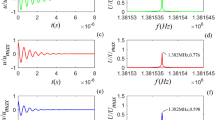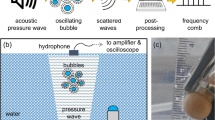Abstract
THERE are points still uncertain concerning the velocity of sound in fluids contained in tubes. Relatively little experimental work has been carried out in liquids as the contained fluid, but outstanding is the research of Dorsing (Ann. der Physik, 25, pp. 227–251; 1908), who reported certain cases of increase of the velocity as compared with the velocity in the same liquid when unconfined. Generally there is expected a decrease in velocity depending on the diameter of the tube. Unlike most experimenters, Dorsing employed a relatively high frequency in his experiments, about 4000 vibrations per second; so also did Busse (Ann. der Physik (4), 75, pp. 657–664; 1924), who adopted Dorsing's method to determine some useful thermodynamical constants.
This is a preview of subscription content, access via your institution
Access options
Subscribe to this journal
Receive 51 print issues and online access
$199.00 per year
only $3.90 per issue
Buy this article
- Purchase on Springer Link
- Instant access to full article PDF
Prices may be subject to local taxes which are calculated during checkout
Similar content being viewed by others
Author information
Authors and Affiliations
Rights and permissions
About this article
Cite this article
BOYLE, R., FROMAN, D. Velocity of Sound in Tubes: Ultra-Sonic Method. Nature 126, 602–603 (1930). https://doi.org/10.1038/126602a0
Issue Date:
DOI: https://doi.org/10.1038/126602a0
Comments
By submitting a comment you agree to abide by our Terms and Community Guidelines. If you find something abusive or that does not comply with our terms or guidelines please flag it as inappropriate.



